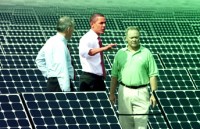 The Obama Administration's recently released "Economic Report of the President" devoted an entire chapter to "Transforming the Energy Sector and Addressing Climate Change" [.pdf]. Whenever the government promises to transform an entire sector of the economy, we know to watch out. Upon a simple reading it is obvious that the president's fancy economic rhetoric doesn't justify the $60 billion in "stimulus" funds and the proposed new mandates on the private sector. Even the report's own analysis shows that the likely damages from climate change are comparable to the economic damages of more government regulation.
The Obama Administration's recently released "Economic Report of the President" devoted an entire chapter to "Transforming the Energy Sector and Addressing Climate Change" [.pdf]. Whenever the government promises to transform an entire sector of the economy, we know to watch out. Upon a simple reading it is obvious that the president's fancy economic rhetoric doesn't justify the $60 billion in "stimulus" funds and the proposed new mandates on the private sector. Even the report's own analysis shows that the likely damages from climate change are comparable to the economic damages of more government regulation.
 Some people argue that we must reduce our use of oil because some oil is produced by dictators and countries with interests contrary to the United States. They argue we need to switch to different technology such as hybrids and renewables to reduce power these dictators could exert on the United States.[a]
Some people argue that we must reduce our use of oil because some oil is produced by dictators and countries with interests contrary to the United States. They argue we need to switch to different technology such as hybrids and renewables to reduce power these dictators could exert on the United States.[a]
A little more than three months ago, IER reported that stimulus funds for green energy projects were heading offshore, along with U.S. manufacturing.
In recent statements both President Obama and Senator Lindsey Graham have harped on the theme that giving subsidies to so-called “clean” energy while taxing fossil-based fuels at the same time are part of a “market-based” solution to the nation’s challenges. Besides the Orwellian idea that government intervention is market-based, Obama and Graham’s remarks underscore just how remarkably inefficient “clean” energy sources are. In order to compete, these “clean” energy sources not only need a handout from the government, they also require that the Government kick their competitors in the face. And sometimes that’s not even enough.
The Obama Administration today released its proposed FY 2011 budget. Not surprisingly, it contained $36.5 billion in new taxes over ten years on the oil and gas industries, while heaping new billions in taxpayer support for politically-favored energies. Such policies are never a good idea, but they are particularly destructive in the midst of a severe recession. Levying new taxes on efficient energy, and new subsidies for inefficient energy, is a recipe for higher prices and fewer jobs.